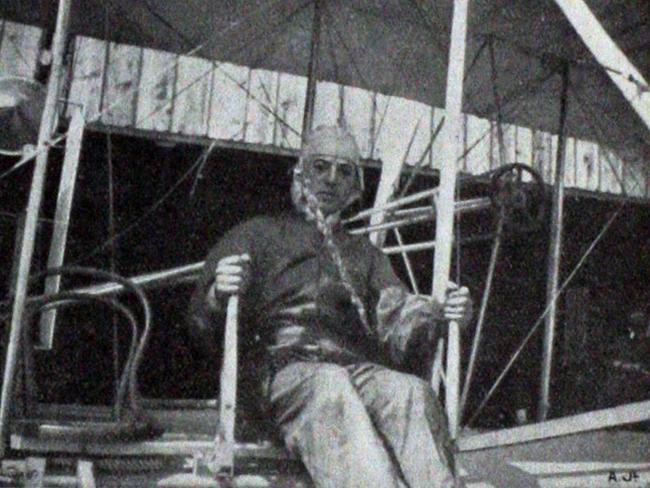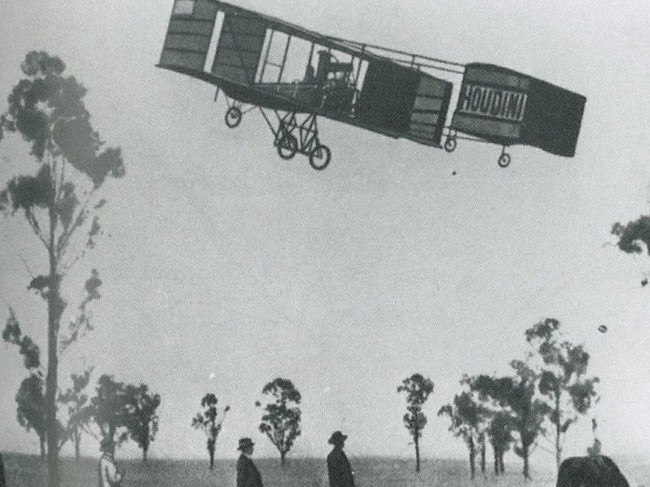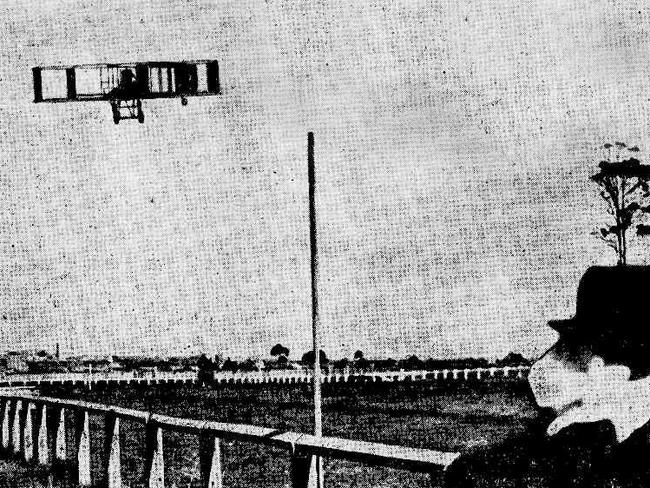The race to be the first into the air over Australia was undecided for decades
When Harry Houdini escaped the bonds of gravity at Diggers Rest in Victoria in 1910 he claimed to have been the first to fly an aeroplane in Australia, but in fact somebody had beaten him to it
The name Harry Houdini was mostly associated with slipping free of chains and ropes, but in 1910 he was focusing on freeing himself from the bonds of Earth’s gravity.
The world renowned escapologist had discovered the joys of aviation, commissioned his own custom-made Voisin aircraft and brought it to Australia with the aim of becoming
the first person to fly a plane on this continent.
On March 18, 1910, he made three successful flights from a paddock at Diggers Rest in Victoria to be hailed as the first person to take a powered aircraft into the air in Australia.
In fact he had been beaten to the achievement by someone else.
In December 1909 Englishman Colin Defries flew his Wright Model A aircraft over about 115 yards (105 metres) at Victoria Racecourse in Sydney.
But for decades Houdini was acknowledged as the first — partly because he got more publicity, but also partly because his flight was more impressive than Defries’ effort. When Houdini’s record was finally challenged Defries was given some of his due.
The men were contestants in an air race in which it took decades for a winner to be declared.
Even before the Wright brothers achieved their milestone of controlled, powered flight in 1903, Australians were fascinated by the idea of launching themselves into the air.
Lawrence Hargrave became famous for experiments with box gliders, which looked like large kites.

In 1894 he was lifted into the air by one, proving flight was possible in a heavier than air machine. His designs influenced American pioneer aviation engineer Octave Chanute, whose designs were a major influence on the Wright brothers.
But it would be six years after the Wrights’ flight in 1903 before anybody would take to the air in Australia in a powered aircraft.
The race to be the first began in earnest in September 1909 when the government announced a reward of £10,000 for the development of a practical military aircraft.
Dozens of people either imported machines or began trying to build their own, trying to claim the prize.

One was architect turned artist, journalist and aviation enthusiast George Augustine Taylor, born in Sydney in 1872. A tinkerer and admirer of the work of Hargraves, Taylor built his own glider and launched it at Narrabeen on December 5, 1909.
He flew for an impressive 110 yards (100 metres). But because he was not able to keep the craft in the air for longer or to take off again quickly, he didn’t take the government’s money.
Big hopes were held for the Englishman Defries, who had spent eight months in France learning to fly. Born in 1884 in London, he had initially made his name driving cars before he became interested in aircraft.
After his flying lessons in France he was brought to Australia in 1909 by theatre impresarios J & N Tait, for a flying tour. He was also hoping to claim the government’s prize.
But in a Daily Telegraph interview in November 1909 he said that one of the government’s conditions was that the plane “must hover”. He said they may as well have offered £100,000 since nobody would ever claim it, because no machine was capable of hovering.
After several attempts he finally made it into the air aboard his Wright monoplane called The Stella on December 9.

The flight only lasted a few seconds but covered more than 100 metres. On December 18 he tried again, this time staying up for longer and covering 300 yards (274 metres).
Because he made no turns
and didn’t seem to be really be in control of the flight, it was later dismissed by some aviation enthusiasts. Australian Ralph Banks took Defries’ plane and went to Diggers Rest in Victoria where,
on March 1, 1910, he flew for about 274 metres before crashing.
On March 17, another Australian Fred Custance, also claimed to have flown for a sustained flight, which included turns, but because there were no “independent witnesses” his flight was dismissed.
On March 18, Houdini’s much publicised flight was well and truly attested to and because he stayed in the air, controlling his aircraft, this was seen as the first significant powered flight. He made 18 more flights on a tour of Australia, proving it was no fluke and cementing the idea in the minds of many people that he was the first man to fly in Australia.
It would be decades before anyone re-examined Defries’ claim to being first, but in 1988 a Civil Aviation Authority panel decided that by
getting into the air, albeit briefly, Defries had qualified as the first to fly an aeroplane in Australia.



